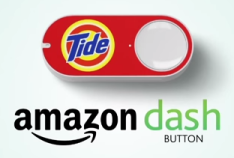Why Amazon’s Dash Button might be the marketing innovation of the decade
 In this guest post, Eaon Pritchard argues that getting upstream of the problem means that commodity brands can finally forget about notions of ‘engagement’ and just be happy with selling more stuff more often.
In this guest post, Eaon Pritchard argues that getting upstream of the problem means that commodity brands can finally forget about notions of ‘engagement’ and just be happy with selling more stuff more often.
We conducted a small survey on supermarket shopping behaviour using the agency staff as our sample group of around 50.
It was relatively unscientific, however, the aim was to crudely test one particular covert thought. We simply asked our respondents if they used a shopping list when visiting the supermarket.For those who answered ‘yes’ we asked them to provide an example of a typical shopping list.
For those who answered ‘no’ we asked them to jot down what their mental list might typically be, anyway.


“Tide is now happy just to be bought.” Thanks for an awesome read Eaon.
Good piece.I’m not so sure people will want these buttons scattered around their kitchen, but imagine there would be cluster of buttons hidden somewhere in the pantry. I need to get a hold of the Sorenson book, but two questions come to mind, Eaon.
How many of the ‘5 or less’ items would be considered commodity; i.e. the sort of thing that can be replaced by a button?
Does the ‘5 or less’ trip to supermarket itself imply something other than necessity; i.e. a reason for just getting out of the house?
Reminds me of the great Pizza Button idea launched in Dubai in 2012 – check it out
http://www.cnet.com/au/news/pi.....er-button/
Solid. As always from Pritchard.
Slowly chipping away at the madness…
Skewed sample of young agency types. 5 items or less? Pah!
Get the point on milk and veg but the last 3 feet is where brand comes into play.
Stopped reading after this…
@jimmy tarbuck
Young agency types! I resemble that remark.
I admitted it was relatively unscientific but can assure you we have decent representation of over 40’s etc.
Go and look at the data, it’s in Sorensen’s research and also referenced in Byron Sharp’s textbook (Ch 8).
This doesn’t negative the role of brands/brand advertising because they help make decisions easier in a complex world (and help ‘sell’ dash buttons), but the most important point here (as has been made by Adam Ferrier) is that there are two ways to drive behavior:
1) increase motivation
2) make something easier to do.
In advertising we’re too obsessed with the former when as Amazon has successfully identified ‘ease’ is often a far greater driver. It’s not as sexy, but it’s more interesting.
Well said, Eaon. There are huge marketing opportunities for those who grasp the fairly simple concept that people are far from ‘engaged’ when it comes to low-involvement purchases. Our industry needs to pay greater heed to realists like Byron Sharp (and you, of course) and less to fantasists like Kevin Roberts.
you had me at ‘refreshingly Nietzschean in its acceptance of the kind of emptiness of consumption’.
Great piece Eaon.
Like most of my friends I now do grocery shop online, only entering a physical supermarket when we have run out of milk. The online shopping portal offers a list of previously purchased items, as our eating habits don’t change significantly from week to week I usually just go through and tick what we need from this list, tick, tick, 10 minutes & the shopping is done. This has created an accidental brand loyalty, I continually just tick/buy the same brand that we have previously purchased, without searching for any other brands. Occasionally I look in the sale section, but it is contains 1000+ items and just turns into a tedious exercise just to save a couple of cents. So there you go, my laziness or perceived shortage of time has led to my brand loyalties.
@Eaon, could you please post up some more information about Byron Sharp’s textbook (as referenced in post 6)?
@B
It’s this one. ‘Marketing: Theory, Evidence, Practice’
http://www.bookdepository.com/.....0195573558
@Eaon
Thank you, much obliged!
This article was informative. I am gob-smacked. People cry about being time poor and yet they go to a supermarket for ONE item? Or 5? Maybe my early training comes into play – living on a farm a fair way out of town, we always had a main purpose for a trip in – and there were at least a half dozen of secondary chores/ reasons. Having learnt to “make a trip worth the petrol” from a young age, I can’t conceive of standing in a supermarket line for one item – even with tap and go available.
Wow.
To be fair, surveying agency staff is well beyond “not scientific”.
That is the most unrepresentative group of supermarket users you could possibly find.
Interesting ready though
lovely piece of work Eaon. facilitating our laziness and indifference is a smart move from amazon.
@B. Also look for Prof. Byron Sharp’s ‘How Brands Grow’.
@John, I certainly will thank you.
Great point about loyalty. I think this will get really interesting when products themselves have this technology built in. Amazon also launched the ‘Dash Replenishment Service’ alongside that which is the beginnings of this. Waiting for the day when someone’s toddler orders 200 boxes of TIDE by mistake…
Great piece. And also nice to see a bit of innovation within a category usually fought within trade and supermarkets!
I actually do love my washing powder . The brand Eco- store from NZ is an incredibly loved brand and does cut through the habitual in that aisle .